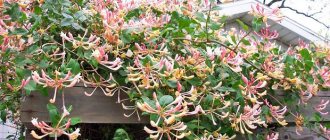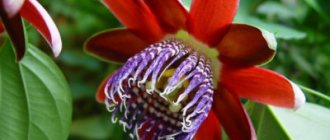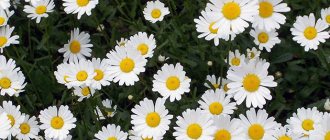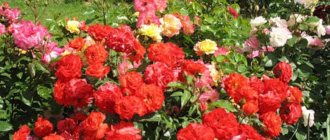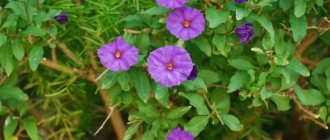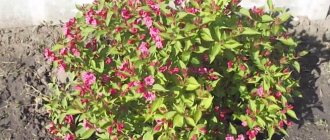Bladderwort is a deciduous shrub belonging to the Rosaceae family. It got its name from its bubble-shaped fruits. Grows mainly in northern America and eastern Asia.
There are several dozen different species and varieties of bladderwort, located virtually all over the globe. In gardening it is used as part of landscape design to give the site a beautiful, original look.
Biological description
Bladderwort bushes of different varieties
Bladderwort is an ornamental deciduous shrub that belongs to the Rosaceae family. The genus Bladderwort has more than 10 species, of which the most widespread and popular is the viburnum-leaved bladdercarp. The shrub grows from 1 to 3 meters in height.
Bladderwort is used both in single and group plantings, as well as for creating hedges and landscaping streets, squares, and park areas. This plant is native to East Asia and North America. In the USA and Canada it grows wild in mixed forests, valleys and along river banks.
Description of the bladderwort:
- The bark is brown or brown. It tends to flake off with age
- The leaves are ovoid or elliptical in shape, small in size, approximately 4-10 cm long. The edges of the leaves are serrate-toothed. On the upper side, the leaf plates have a dark and rich shade, and on the lower side they are painted in lighter colors
- The flowers are white or pink, collected in convex corymbose inflorescences. The shrub blooms in June-July and blooms for two to three weeks.
- The fruits are miniature leaflet bubbles collected in scutes
Bladderwort blooms
The unusual shape of the fruit gave the plant such an unusual name - vesicular carp. In Latin it sounds like Physocarpus. This name comes from two Greek words: physo, which means "bladder" and carpos, which translates as "fruit".
Popular varieties of bladderwort
The most popular viburnum-leaved varieties include varieties with red and yellow colors. These two groups combine effectively both with each other and with bushes of traditional green color. Plants with dark purple leaves also look very elegant - snow-white flowers and berries stand out against their background, creating a pleasant contrast.
Advice! A good example is the combination of the viburnum-leaved varieties Diabolo and Darts Gold. The alternation of yellow and maroon blocks in the hedge gives it a festive look.
The leaf blade of the Diabolo variety is dark green on top, approaching burgundy color
Bladderwort: decorative and unpretentious shrub
In Russia, the bladderwort first appeared at the end of the 18th century in the botanical garden of St. Petersburg. During the 19th century, several more plant species were introduced from North America.
THIS SHRUSH:
- is unpretentious, has high winter hardiness
- tolerates city conditions well
- not too picky about soil composition
- begins to bloom and bear fruit at the age of 4 years
- does not tolerate excess moisture and moisture stagnation
The bladderwort remains decorative throughout the entire growing season. At the same time, the shrub is very unpretentious.
However, there are two requirements that must be met in order for this plant to be comfortable in the garden:
1 Lack of lime in the soil. On soils with a high lime content, the shrub will develop poorly.
2 Availability of drainage. The bladderwort does not tolerate stagnant moisture, and soils with high groundwater levels are not suitable for it.
Although this shrub is not too demanding on the composition of the soil, it will respond to a loose, fertile and fertilized substrate with good growth and a lush appearance. The plant is resistant to air pollution. For this reason, it can be grown near roads.
A huge advantage of the bladderwort over other ornamental shrubs is its good winter hardiness. In the middle zone it overwinters without problems, and only very severe frosts can damage the tips of its shoots.
Bubblewort chameleons
Chameleons are varieties of the vesicular carp that change color during the growing season. Among them there are varieties with monochromatic colors and plants whose leaf blades are painted in at least two colors.
Enis Gold
Enis Gold is an elegant variegated variety of compact size. It rarely grows above 1.2-1.5 m; the plant also reaches a width of approximately 1.4-1.5 m. A distinctive feature of the variety is the double color of the leaf blade. The yellow-green leaves seem to be covered with spots that form an interesting mosaic.
Despite the traditional green color, the shrub looks elegant due to the combination of dark and light tones
Copertinna
Copertinna is a variety developed during breeding work based on the Darts Gold and Diabolo varieties. The height of the vesicular carp viburnum leaf Copertinna can reach 1.5-2.5 m. The foliage of the shrub is orange, however, in summer it becomes dark red, approaching brown tones. Copertinna's flowers are initially white, but after a while they turn pink.
The decorative effect of the Copertinna variety is given by the reddish color of the shoots
Amber Jubilee
Amber Jubilee is a viburnum-leaved bladderwort of British origin. The crown of the plant is quite dense, compact, about 1.3-1.5 m in diameter. Throughout the growing season, the color of the foliage gradually changes from yellowish-purple tones to light green. In autumn it turns orange-bronze.
The Amber Jubilee variety has a pleasant brick-colored foliage.
Chameleon
Chameleon bladderwort is a fairly compact viburnum-leaved variety with an unusual foliage color. In young bushes, the leaf blade has a purple edging along the very edge, however, over time it becomes light green. The main color of the leaves is greenish-brown. The flower petals of this variety are creamy white.
The height of the plant is on average 1-1.5 m.
At the base, the leaves of the Chameleon variety are sometimes colored red
Landing
Bladderwort can be grown both in the shade and in lighted areas. However, varieties with purple and gold leaves will have brighter colored foliage in sunny areas. In the shade, the color of the leaves fades over time and becomes muted.
Viburnum-leaved species (Red Baron)
Therefore, if you want to achieve a greater decorative effect from this plant, you should choose an open sunny place to plant it. For planting, it is better to purchase material from a nursery, where they sell shrubs in special containers, ready for planting.
Such seedlings with a closed root system can be planted not only in spring, but also at any other period during the growing season.
Planting bladderwort
How to plant this shrub correctly so that it takes root and grows quickly:
1For planting, prepare a hole with a depth and diameter of 0.5 meters. Fertile garden soil, peat substrate or humus should be placed at its bottom.
2The plant along with the lump of earth must be carefully removed from the container and placed in the prepared planting hole. At the same time, it is important not to damage the roots and try not to straighten them.
3The hole with the plant should be filled with soil, preferably fertile, and the seedling should be deepened by 5 cm. This technique will help the bush produce additional new shoots from dormant buds.
4After planting, the bladderwort bushes should be watered with water, to which Kornevin can be added, and then the trunk circle should be mulched.
Young bush of the Coppertina variety
With such treatment, a surface crust will not form, and the roots of the plant will be able to receive a sufficient amount of air.
Brief rules for growing bladderwort
The table provides brief rules for growing bladderwort in open ground.
| Landing | Bladderwort with a closed root system can be planted throughout the warm season - from spring to autumn. It is recommended to plant seedlings with an open root system in autumn (less often in spring). |
| Lighting level | A bright and open corner, away from large plantings, is suitable. Green-leaved varieties can tolerate partial shade. |
| Watering mode | In hot and dry summers, watering is carried out approximately twice a week. The rest of the time, the bushes may have enough precipitation. |
| The soil | The composition of the soil is not critical, but it should not contain lime. |
| Feeding | Feeding the bladderwort is carried out twice per season - in spring and autumn. You can also use special formulations intended for ornamental shrubs. |
| Bloom | Flowering usually begins in early summer. |
| Trimming | To maintain a healthy and attractive appearance, the bushes will require regular pruning. |
| Reproduction | Seeds, cuttings, layering, dividing the bush. |
| Pests | Pests almost never attack bladderworts. |
| Diseases | Chlorosis, powdery mildew, rot. |
Reproduction
This shrub reproduces in several ways. Each of them has its own characteristics that you need to pay attention to.
Propagation by seeds
Bladderwort fruits with seeds
Bladderwort seeds give good germination, but with this method of propagation there is no guarantee that all varietal characteristics will be preserved. There is a high probability that bushes grown from seeds will have green rather than red leaves.
For this reason, propagation by seeds is extremely rare. To preserve the original color of the leaves, the vesicular carp should be propagated vegetatively.
Cuttings
Propagation by cuttings
This is the simplest and most popular method that gives quick and traditionally good results. For propagation by cuttings, green shoots are used, which are cut 10-20 cm long. It is important that each cutting has several growth points.
Cuttings are carried out in spring or early summer, before the bush blooms:
1The cuttings are separated, the leaves are removed from the lower half of the shoot, and the leaves from the upper half are shortened by half. You can also scratch the skin at the base of the cuttings: it is believed that roots form faster in these places.
2The bases of the resulting cuttings are soaked in any of the root formation stimulants. This step is not necessary, since the bladderwort can root successfully without stimulation.
3The shoots are planted in river sand or a substrate consisting of sand and peat.
4After planting, the cuttings should be watered and covered with plastic wrap.
5Follow-up care before the start of winter consists of ventilation and systematic moisturizing. When new leaves and shoots begin to appear, indicating successful rooting, the film can be removed.
6For the winter, rooted cuttings should be covered, preferably with spruce branches. The bases of the stems are mulched with leaves, peat or soil.
7In the spring, the young shoots can be planted in a permanent place.
Dividing the bush
Young plant bushes
This method is less popular than cuttings because it requires physical effort, and the number of young plants obtained by dividing the bush is very limited. One well-developed adult bush can be divided into 4-6 parts.
The bush should be divided in early spring, before the period of active growth begins.
This procedure is possible in the fall, after the bush has faded and there is at least a month and a half left before frost:
1 Planting holes are prepared for the cuttings, and the stems are cut at a level of 60-70 cm. This will only benefit the bladderwort and will be an additional incentive for the appearance of new shoots.
2The plant is carefully dug up, completely removing the root system from the soil.
3The bush is divided in such a way that each part gets a good rhizome and one powerful healthy branch more than 20 cm long.
4The separated parts must be planted in a new place as quickly as possible to prevent the roots from drying out.
5After this, the plants are watered and the soil is mulched to avoid crust formation.
6In the first year, separated young plants need shelter for the winter.
Reproduction by layering
This is a fairly common method of reproduction. This procedure is carried out in April, after the first leaves appear on the shoots, so that the cuttings have time to take root during the growing season.
The order of propagation by layering is as follows:
1C of the shoot, almost all leaves are removed, except those at the very top.
2 Make a groove in the ground under the branch up to 10-15 cm deep.
3 Without cutting off the prepared shoot from the bush, place it in a groove, pin it to the ground and cover it with fertile soil. The tip of the shoot must be left open without being covered with soil.
4It is important to water the soil during periods that are too dry, because without moisture, roots that are not yet fully strong may die.
5At the end of autumn, young rooted bushes are separated from the adult plant. For the winter they should be covered with spruce branches.
6This type of laying of layering gives good results if you choose strong and healthy shoots directed outward for them.
Reproduction of bladderwort
Obtaining young shoots of this plant is possible in various ways, each of which is endowed with a list of specific advantages.
Cuttings
For this, shoots at least 15 cm long are used. The cuttings are cut before the bush begins to flower, otherwise it can be significantly damaged.
After harvesting, the cuttings are treated with special solutions and placed in a greenhouse.
Layerings
The simplest existing method. It involves rooting a young shoot that grows at the edge of the bush. It is cleared of the lower leaves, then fixed in a groove, 10 cm to 12 cm deep. The layer is placed in the hole and sprinkled with soil.
Dividing the bush
This procedure is recommended to be carried out 2 times a year, in spring or autumn. However, do not forget that the root system of a plant outside the soil dries very quickly.
Seeds
The most difficult of the methods.
It is used much less frequently than others because young shoots can have a completely different color than that of the shrub from which the seeds were taken.
Care
Despite its high decorative value, bladderwort is a very unpretentious plant . It does not require any special care, but certain conditions must be observed: regular pruning, watering the plants and fertilizing.
When grown correctly, the bushes will be practically not affected by diseases and pests.
Beautifully shaped bush
Trimming
The shrub can grow up to 30-40 years, and during the growing season it can develop at a fairly rapid pace. When favorable conditions are created, the vesicular carp can grow up to 40 cm in one year, both in height and width.
In what cases does a plant need pruning?
- to stimulate active shoot growth
- if the crown needs to be given a certain shape
The bladderwort tolerates the pruning procedure painlessly, and subsequently quickly grows overgrown with young shoots.
In addition to formative pruning, a sanitary procedure is also carried out:
- Sanitary pruning is carried out in early spring. Its purpose is to remove broken, dried branches and shoots frozen in winter
- Formative pruning is needed to give the plant the required shape. It is also carried out in the spring, even before the buds bloom on the bush, or in the fall, after the growing season is over.
There are two types of shaping pruning that can be used:
- if the purpose of pruning is to obtain a powerful and wide bush with a large number of trunks, then it is carried out at a level of 40-50 cm
- To give the plant a so-called “fountain-shaped” shape, cut out all the thin shoots at the base of the bush, leaving up to five of the strongest and strongest branches. To stimulate growth, these shoots are also additionally pruned at a height of 1.5 meters
Watering
The frequency of watering shrubs depends on several factors:
1Type of soil
2Plant age
3Climatic zone where it grows
If the soil in the area where the shrub is grown is loamy, and high temperatures are possible in summer, then the plant needs regular watering (at least twice a week). However, overflow and stagnation of water should be avoided.
When overmoistened, the bladderwort bush runs the risk of becoming infected with powdery mildew . This can lead to the death of the plant.
Top dressing
By fertilizing the bush you can get a beautiful and lush shape.
Fertilizing shrubs is carried out twice per season, in spring and autumn:
1 In early spring , when the buds open, it is necessary to apply nitrogen-containing fertilizer.
2 In autumn it should be replaced with mineral fertilizer.
Plants respond well to fertilizer, forming a lush, dense crown.
Wintering
The advantages of this shrub include good winter hardiness. In the middle zone, the bladderwort overwinters without shelter. At the same time, freezing of the tops of the shoots is observed only in rare cases and during very frosty winters.
Only young shoots rooted this year need shelter for the winter . In autumn, after pruning, the soil around the plants should be mulched with a layer of peat at least 8 cm high. After this, the young plants should be covered with spruce branches.
Pests and diseases
The bladderwort has good resistance to diseases and pests. But bushes growing in poor soil may suffer from chlorosis. In this case, the tops of the shoots may dry out and fresh leaves may turn yellow. For such symptoms, it is necessary to spray the foliage or water the bladderwort with a preparation containing iron in a form accessible to the plant. Iron chelate is best suited for this. Such measures will allow the plant to recover quickly.
If the bushes are located in a low area or grow in heavy soil and are watered too often, rot may develop on the roots of the bladderwort. The leaves of such bushes wither and dry out, and powdery mildew appears on them. Affected branches must be pruned and burned. If possible, the care of the plant should be adjusted or transplanted to a more suitable place.
Pests almost never attack bladderworts, so the bushes do not need special preventive treatments.
Kinds
There are more than 10 species of this plant, but only two species are widespread in cultivation in the European part of the country:
- Amur bladderwort (Physocarpus amurensis)
- Physocarpus opulifolius
Unpretentious, decorative and fast-growing vesicles are an excellent material for hedges. They tolerate pruning well, with which the bushes can be easily given the desired shape.
The Amur bladderwort is used less frequently in landscaping, but the most widely used plant is the viburnum-leaved bladdercarp in landscape design.
1
Amursky
Amur bladderwort
The homeland of this shrub is the mixed forests of the Far East, North Korea and northern China. The bushes grow up to 3 meters in height.
The crown has a wide spherical shape, green leaves and blooms with small white flowers collected in corymbose inflorescences.
The fruits are swollen leaflets that turn red as they ripen and give the plant an attractive appearance and decorative appearance in the fall. This species is winter-hardy.
The shoots become completely woody. The plant is used both in single and group plantings, as well as as hedges.
2
Bladderwort viburnum
Bladderwort viburnum
This plant is native to North America, where it grows wild. The shrub got its name because of its leaves, which are similar to those of viburnum.
For decorative decoration of a garden plot, mainly two groups of varieties of viburnum are used: plants with red leaves and with yellow foliage.
In each of the groups, breeders have developed many varieties, which are worth dwelling on in more detail.
Description of the bladderwort
Bladderwort bushes have drooping shoots that make up a spreading spherical crown. The bark of adult specimens gradually begins to peel off from the trunk. The size of the bushes reaches 3 m. The alternate foliage is slightly reminiscent of viburnum and has from 3 to 5 blades. The color of the leaves may depend on the variety. Often their shade can change up to several times per season. The leaf surface may be bare or pubescent.
The inflorescences of the vesicular carp have the shape of a shield, forming a hemisphere up to 7 cm in diameter. They are made up of small white (or pinkish) flowers with 5 petals and many long stamens. Flowering occurs at the beginning of summer, but the fruits of the bush look no less impressive, giving it its name - swollen leaflets. As they ripen they turn red.
In gardening, only two existing types of bladderwort are used. But based on them, many spectacular varieties of shrubs were obtained, differing in the color of their foliage.
Bladderwort viburnum Planting and care, propagation and pruning
The most popular red-leaved varieties
This group is especially valued by gardeners and designers for its high decorative qualities. The foliage of these bladderworts, colored in varying shades of red and purple, looks very festive. Against the background of leaves, white and pink inflorescences in summer and clusters of berries in autumn look impressive.
Red-leaved varieties prefer open sunny areas. In the shade, they lose their “zest”, because due to the lack of sunny color, the bright purple color of the leaves quickly turns into ordinary green.
"Diabolo"
Diabolo Diabolo is a spectacular variety with dark purple glossy leaves of uniform color and a thick, lush crown.
Powerful bushes grow up to 3 meters in height and need pruning. With the onset of autumn, the color of the leaves does not change.
In the shade, the leaves turn green with a slight purple tint. The variety was awarded the prize of the English Royal Horticultural Society.
"Red Baron"
Red Baron The Red Baron bladderwort bush can have a beautiful spherical shape. It reaches up to 2 meters in height and the same in width.
The leaves of this variety are up to 7 cm long, dark red in color, slightly elongated and corrugated.
With the onset of autumn, the foliage takes on a bronze hue.
"Summer Vine"
Wine Summer Wine has a crown with spreading branches and deep wine-colored foliage with a metallic sheen.
The bush grows 2 meters in height. In spring it blooms magnificently, the shoots are completely covered with white and pink inflorescences.
This variety can tolerate severe frosts well, so it is suitable for growing in almost any region.
"Lady in Red"
Lady in Red Plants of this variety of English selection have reddish foliage and pale pink flowers. Lady in Red bladderwort does not exceed 1.8 meters in height.
With the onset of autumn, the elegant foliage of the Lady in Red variety tends to darken.
The decorative qualities of this shrub were awarded by the English Royal Horticultural Society.
"Andre"
Andre The Andre bladderwort has a height of no more than 2 meters and the same width. The leaves, orange-red when blooming, acquire a bronze-red hue closer to the beginning of summer.
They are up to 10 cm long and elliptical in shape.
This variety blooms in June with creamy white or pale pink flowers, in place of which bright red berries are formed.
"Noise"
Schuch Bladderwort Schuch has wine-red foliage and blooms in late spring with white-pink flowers.
The shrub grows 2 meters in height and width. Resistant to frost and adverse factors.
With the onset of autumn, the color of the foliage does not change.
"Little Angel"
Little Angel Little Angel is a low-growing shrub growing in height and width up to 1 meter. The leaves are small, 2 times smaller in size than those of tall varieties.
Young orange-red foliage eventually turns deep burgundy, with orange-red shoot tips.
"Midnight"
Midnight Midnight is the darkest of all bladderwort varieties. The leaves of an adult plant are almost purple-brown in color.
The flowers are pink and white. The bush is medium in size, reaching 1.8 meters in height and 1.5 meters in width.
In autumn the leaves turn orange-red.
"Little Joker"
Little Joker Little Joker, bred by breeders in the Netherlands, is a dwarf variety. The height of the bush is from 50 cm to 1 meter.
The leaves are small, burgundy-purple. As autumn approaches, the foliage takes on a dark purple-brown hue.
The flowers are pinkish-white and appear in June. If desired, plants of this variety can be grown in containers.
"Tiny Vine"
Tiny Wine Bladderwort Tiny Wine is a low-growing variety. Plants reach a height of up to 1.2 meters. This shrub will be an excellent option for small garden plots.
The dark burgundy leaves are practically invisible in spring due to the fact that the branches are completely covered with a large number of white and pink inflorescences.
In autumn the leaves turn bright red.
Varieties of bladderwort: photo and description
Based on the two species, a huge variety of varieties have been created, which are conventionally divided into yellow-leaved and red-leaved. Each of them is decorative in its own way and has a unique flavor, attracting attention to its unusual appearance. The main distinguishing features are the size, shape and color of the leaves.
Varieties of the Amur species
Varieties of bladderwort, photos and descriptions represent the Amur varieties of ornamental plants:
1. Luteus is one of the well-known varieties that forms a large crown. It grows up to 4 m wide. It is interesting for the color of the foliage: in summer it is bright yellow, and by autumn it changes to red or crimson. Bright shades of foliage set off the white inflorescences. The bush grows well in partial shade, but the color of the foliage becomes duller. The Luteus variety is undemanding to soil conditions and moisture. It is frost-resistant due to its shoots that quickly grow bark.
2. Aureomarginata has an unusual color of the leaf blade, which forms a dark golden edge along the green leaf. Variegated foliage looks original and attracts attention. Additional charm is given by the white shields of flowers that bloom in June and the red autumn fruits. To maintain its decorative appearance, the variety needs good lighting. The bush reaches standard sizes - 2.5 m.
3. Nana belongs to the dwarf varieties that grow no more than a meter. Red-brown shoots grow vertically. The dwarf variety is beautiful with pink flowers that set off the bright green foliage. The variety forms a dense and compact crown. Beautiful in compositional variants and interesting as a solitaire.
Note: The bladderwort, the varieties of which are presented here, adorns parks, alleys, and gardens. Used in cultivated plantings since 1854. Amur varieties are undemanding to care and tolerate crown formation and cold weather well.
Varieties of viburnum-leaved species
They grow wild in the forests of North America. They settle along steep river banks. They form a thick, almost impenetrable crown. The varieties of bladderwort presented in the article were created on its basis:
1. Diablo is a popular and large three-meter variety, the hallmark of which is dark purple foliage. It retains its special color scheme throughout the growing season. If the variety grows in the shade, then the foliage completely loses its decorative effect, acquiring the usual green color. White or pink flowers bloom on the plant, against which the foliage plays with rich colors, and the bright red fruits are lost in it. Grows well in acidic, loamy soils. Does not like stagnant moisture, which affects the root system. It is able to grow in environmentally polluted areas, tolerates city conditions well, and therefore is an inhabitant of city gardens and park areas.
2. Darts Gold resembles the Luteus variety, but it is a more advanced version. It forms a rounded crown both in width and in height reaching 1.5 m. At the beginning of growth it is overgrown with green foliage, which gradually becomes lemon-yellow. Forms a white-pink shield and blooms for 3 weeks. By autumn the foliage turns yellow-bronze. Like other bladderworts, the foliage loses its rich color in the shade. It tolerates drought and frost well, but is intolerant of moisture stagnation.
3. Red Baron forms a spreading two-meter crown. The leaves have a slightly different shape: they are narrower, longer, oblong, and jagged along the edge. The bush is covered with red foliage in the summer season, which turns dark bronze in the fall. The decoration is represented by umbrella-shaped white and pink inflorescences up to 5 cm in diameter. Bright red fruits are set off by foliage of darker tones. The variety loves a lot of light, is undemanding to soils and moisture, and is winter-hardy. It grows quickly and is often used to create green urban landscapes.
4. Andre forms a wide, spreading crown. The lobed and elongated leaves have a purple color, which were green in the spring. In autumn, the bronze tones of the foliage are visible from afar. Forms ball-shaped inflorescences of small pinkish-white flowers. The variety “stoically” tolerates drought, strong winds, and unfavorable urban conditions. It is grown in garden and park areas, where it creates interesting contrasting compositions.
Note: The dwarf variety Little Angel (50 cm) due to its compact crown is suitable for growing in flowerpots. The bush is covered with small burgundy leaves, the edges of which are wavy. They are set off by creamy inflorescences, creating an unusual combination.
5. Amber Jubile is one of the modern varieties that grows up to 2 m. It is interesting with its oval crown and repeated color changes during the season. The color of the leaf blade changes from yellow to orange, turning into brown, and by autumn it turns purple. Hemispherical inflorescences of white flowers hang from the tips of the branches. They give rise to red-purple fruits. In the shade, the colors on the leaf blade fade. Grows well on acidic loams where moisture does not stagnate. It can withstand frosts, but sometimes young branches freeze slightly. Plants of this variety are used to create borders and hedges and are used in contrasting compositions. Suitable for city conditions.
6. Golden Nugget is a famous variety. Forms a round, dense crown that is compact. The “ceiling” for growth is 2.5 m. Golden-yellow foliage with an orange edge plays with bright colors. In summer, the leaf blade may turn a little green, but by autumn it will change color to yellow. Pinkish flowers in corymbose inflorescences have a faint aroma. By autumn they produce dark red fruits. The variety is unpretentious, but excess moisture is detrimental to it.
7. Lady In Red is a new product developed in England. The dwarf shrub does not grow more than 1.5 m and forms wrinkled foliage of a bright red hue. By the end of summer, the leaves change color to beetroot. Lush, pink inflorescences are a decoration of the bush. The resulting fruits remain on the branches after the leaves fall. The variety tolerates wind, drought and frost well. This bright, slightly exotic plant will give the garden an additional zest, because the name of the variety translates as “elegant lady in red.”
8. Summer Vine forms a bush measuring 2 m. The leaves are wine-red, rich in color and turn green when placed in partial shade. It has a dense, compact crown. Flowers of pink tones, medium-sized in corymbose inflorescences set off the bright foliage. Grows in dry, fertilized soils and loves plenty of light. Resistant to external adverse factors. Winters well and does not require shelter. Looks interesting in plantings with herbaceous perennials.
9. Aurea is a representative of yellow-leaved varieties. Bright yellow foliage looks advantageous against the background of white inflorescences, and reddish fruits create a single, bright ensemble in the garden area. Young leaves are reddish in color, which gradually turns golden, and by the end of summer - salad green. The bark of non-lignified shoots is also yellow. Due to its unpretentiousness, it is suitable for different climatic zones.
10. Little Devil is interesting because of its hemispherical crown due to upward growing shoots. The bush is small, up to 1.2 m. The name of the variety is translated as “red devil” for its red leaves with purple tones. The bush produces pale pink flowers, collected in dense inflorescences. Flowering duration is 3 weeks. Refers to sun-loving varieties and undemanding to growing conditions. Prefers loams with an acidic reaction and without stagnant water. Used to decorate borders and inconspicuous corners of the garden.
Interesting and unusual varieties of bladderwort
For a long time, spirea was not perceived as something unusual. She grew up everywhere and delighted those around her with her unpretentiousness. But 2003 became a real breeding boom, when European breeders decided to make a bright and exotic shrub from the bladderwort.
Varieties of shrubs with yellow, red and tricolor leaves have been created, among which there are unique specimens. There are also varieties that are similar, like twin brothers. We present several interesting varieties:
· Chameleon is a rare variety with a tri-colored, unusual color. The bush is dwarf, so it can be planted in flowerpots, decorated with borders and garden paths, and used in multi-tiered compositions.
· Amber Jubilee was developed with special secrecy for the anniversary of Queen Elizabeth 2, a great admirer of spirea. The variety is translated as “amber anniversary”. Its first bush was planted in the queen’s garden, and subsequently it became extremely popular among gardeners, as it really has an unusual amber color.
· Diable d'Or' was obtained by crossing yellow and red varieties. The result is a variety with bright orange foliage. It remains “autumn” at any time of the year and does not change its color during the summer. The new bush has many admirers.
Every year new varieties appear on the market, which attract special attention from lovers of ornamental shrubs. They are valued from the point of view of decorativeness, because the endurance and low maintenance requirements of the bladderwort are known to everyone.
The most popular yellow-leaved varieties
Varieties with yellow or yellow-green leaves are no less decorative than red-leaved varieties of bladderwort . They stand out against the backdrop of the dark greenery of the garden and add fresh and bright touches to landscape compositions.
"Luteus"
Luteus Luteus bladdercarp bushes grow up to 3 meters and have a crown diameter of up to 4 meters. The leaves of plants of this variety are attractive with their color, which changes throughout the season.
When blooming, the foliage is yellow with a slight orange tint; in summer it turns yellow-green, and in autumn it takes on a beautiful golden color. The plant is winter-hardy.
"Darts Gold"
Dart's Gold The height of Dart's Gold vesicular carp bushes is up to 1.5 meters. The leaves are orange-yellow when they bloom, turning yellow-green in the summer and turning a gorgeous yellow-bronze hue in the fall.
The flowers are white, with a slight pinkish tint. The variety was awarded by the English Royal Horticultural Society.
"Nugget"
Nugget Nugget bladderwrack bushes grow up to 2 meters. The leaves of plants of this variety are relatively small.
They are yellow when they bloom, but turn green over time. Thick shoots grow vertically and form a vase-shaped bush.
"Enis Gold"
Annys Gold Annys Gold is a variegated variety. The plant has a compact dense bush with a hemispherical crown, carved foliage similar to currant leaves and an unusual variegated color.
The yellow-green leaves seem to be painted with dark green strokes, which form a unique pattern.
"Amber Jubilee"
Amber Jubilee Amber Jubilee is a British-bred vesicle, an excellent ornamental variety. The plant received its name in honor of the Diamond Jubilee of Queen Elizabeth II of England.
The bush is distinguished by its compact crown size, not exceeding 1.5 meters in height and width. The leaves of this shrub have serrated edges.
Over the course of the season, the foliage changes color from yellowish-purple, first to green, and in the fall to orange.
"Aurea"
Aurea The bladderwort Aurea reaches a height of up to 2.5 meters. From the moment the leaves bloom until the beginning of flowering, the plant has bright yellow foliage.
Then it darkens a little, becoming green, and closer to autumn it again acquires a golden yellow hue.
How to care for ornamental shrubs
Watering and loosening
The bladderwort does not require frequent watering. Depending on the soil and climate zone, air temperature, during the season you should rather take care not to flood it too much. To retain a sufficient amount of moisture, the tree trunk circle needs to be loosened and mulched.
Feeding and fertilizer
In the spring it will be appropriate to fertilize with nitrogen-containing fertilizers, and in the fall - with mineral fertilizers.
Shrub pruning
The bladderwort grows very quickly and regularly needs sanitary and formative pruning.
- Sanitary pruning is necessary in the spring; branches damaged during the winter are removed.
- Formative pruning - can be done in both spring and autumn. Proper pruning awakens the upper buds so that they begin to grow. For the density and power of the bush, pruning is carried out at the level of half a meter. Another option is to cut off the strongest branches at a level of 1.5 m, and cut the rest at the root.
Varieties with green leaves
The rich green color of the foliage of these plants allows them to be combined when planting with red-leaved and yellow-leaved varieties . Set off by their unusual color, vesicles with green leaves also look very decorative, especially during flowering.
"Nanus"
Nanus Nanus is distinguished by its compact shape. The height of the bush is usually up to 60 cm and rarely exceeds 1.2 meters.
The bush grows up to 0.9 meters in width. The leaves have a rich dark green hue.
With the onset of autumn, the foliage turns yellow. The flowers are pinkish-white.
"Chameleon"
Chameleon Bladderwort Chameleon has compact bushes with a height of only 1.5 meters and unusual foliage color. The dark green, ruffled leaves feature red, orange and yellow tints.
When young, the leaves have a purple border, and when mature, they have a light green border. This variety blooms with cream flowers.
Bladderwort in winter
Preparing for winter
In the fall, the bladderwort is amazingly beautiful, when the monochromatic foliage begins to dapple with autumn colors. Bladderwort is a fairly frost-resistant plant, and usually in winter only young immature branches freeze on adult bushes, but the cuttings of bladderwort that have taken root in the fall, as well as young bushes, are covered for the winter.
Overwintering of the bladderwort
How to cover a bladderwrack if you are expecting a frosty winter? Carefully tie the bush with twine and cover it with a cone of roofing felt. You can loosely wrap the bush with lutrasil. But first, the soil around the bush needs to be mulched with a layer of peat 5-8 cm thick. After pruning and mulching the tree trunk, it is better to cover young bushes with spruce branches.
Bladderwort in landscape design
Bush in landscape design
This beautifully flowering ornamental shrub is widely used in landscape design, including:
- in single plantings
- in group compositions
- as hedges
Contrasting compositions from a combination of yellow-leaved and red-leaved varieties of bladderwort look impressive. For example, a hedge made on the principle of contrasting plant varieties with yellow and red leaves.
A hedge made from bladderwort looks very decorative, but requires little maintenance, mainly constant pruning. For this plant you will be pleased with the changing shades of foliage depending on the time of year, beautiful flowers that bloom in the spring, and red fruits that ripen in the fall.
Bladderwort is valued in landscape design for its unpretentiousness, fast growth, different sizes, from dwarf to tall bushes, and a wide color palette.
In addition to the traditional green color, bladderwort leaves can be painted in a wide variety of colors:
- yellow-green
- Dark red
- red-orange
- dark burgundy
- golden yellow
- red-purple
- yellow-bronze
- purple violet
- red-brown and many other shades
Such a diverse range of colors allows this shrub to be widely used, creating beautiful landscape compositions.
Bladderwort on the site
Bladderwort goes well with:
- with conifers
- with decorative trees (maple, linden)
- with beautiful flowering shrubs (hydrangea, mock orange)
Hosta, astilbe, foxglove and other flowers look great against its background . Bladderworts with contrasting foliage add variety to the green decoration of the garden, and colorful color accents to the landscape design, which retain their bright shades throughout the season.
If you decide to plant bladderwort on your property, you will not be disappointed. This shrub can become the “highlight” of your garden, and caring for it will not be difficult. This spectacular plant can be grown even in unfavorable areas with poor soils, where other ornamental crops will feel uncomfortable.
Bladderwort care
When caring for such a plant, it is very important to water it on time, since it reacts extremely negatively to drought. When watering, make sure that the liquid does not get on the surface of the leaf blades and inflorescences, because this can lead to burns. In this regard, this procedure is recommended to be performed early in the morning or in the evening. In the hot summer, watering will need to be done approximately a couple of times a week, and 4 buckets of water should be used per bush at a time. Observe the condition of the leaves of the vesicular carp, because not only drought, but also waterlogging of the soil can harm it. If the area is not covered with mulch, then each time after the bush is watered, its surface must be loosened and weeded.
The plant needs to be fed a couple of times a year (in spring and autumn). In spring, you need to feed the plant with the following nutrient mixture: take a five-hundred-gram jar of mullein for 1 bucket of water, as well as 1 large spoon of urea and ammonium nitrate. For 1 adult bush, take 1.5 buckets of this solution. In the autumn, one and a half buckets of a nutrient solution consisting of 10 liters of water and 2 large spoons of nitroammophos should be poured under each bush.
Trimming
This shrub requires systematic sanitary and formative pruning. In spring, it is imperative to prune for sanitary purposes; for this, all injured, diseased, frost-damaged stems and branches, as well as those growing inside the bush, are cut off. By pruning the bladderwort in the fall, you are preparing it for the coming winter. Pruning to form the crown can be done in the fall, but experienced gardeners recommend doing it in the spring. In order for the bush to have the shape of a fountain, you need to cut off all the thin stems at the base, leaving 5 or 6 of the most powerful ones, which need to be shortened a little. If you want the bush to be wide, it needs to be cut at a height of 50 centimeters. When the bush is 6 years old, anti-aging pruning is performed on the stump. On thick stems, the cut points should be smeared with garden varnish.
Pruning shrubs Trimming the bladderwort
Transfer
In some cases, it becomes necessary to replant this plant, for example, you need to move it to another place. If the shrub is already mature, then it should be replanted in early spring, before the buds swell, or in autumn, when the leaf fall ends. The bush is replanted with a sufficiently voluminous earthen lump, and first it is pruned, during which injured, diseased and thickening stems are cut off, and the remaining ones should be shortened to 0.2–0.3 m. Thanks to this, you will be able to put a strain on the root system weaker, because during adaptation it will be extremely difficult for her to feed an adult plant. Transplantation is carried out in almost the same way as planting, only it should be taken into account that in this case the vesicular carp is already an adult. The transplanted bush must be watered using a solution of Heteroauxin or Kornevin, and the leaf plates must also be sprayed with Epin or Ecogel-anti-stress.
Diseases and pests
Planting and growing bladderwort is quite simple, and the gardener will also be pleased with the fact that it has a very high resistance to pests and various diseases. However, if the soil lacks nutrients, the plant develops chlorosis, which causes the apical stems to dry out and young leaf blades to turn yellow. If you notice signs of this disease, you should spray the foliage or water the bush itself at the root with a solution of Ferrilene, Antichlorosis, Ferovit, but experienced gardeners recommend using Iron Chelate. As a rule, after this procedure the vesicular carp recovers very quickly.
How to propagate viburnum leaf carp
One more advantage of the viburnum leaf carp is often used: it is planted en masse in city parks and squares. Experts say that the viburnum leaf carp is very resistant to dust, exhaust gases and other environmental problems of large cities.
This is beneficial for us, amateur gardeners, because it is very easy to get planting material. No! God forbid! There is no need to go dig up planted plants in the park. But, it is quite acceptable to pinch off a twig from an adult plant, or better yet, wait until the utility workers trim the bush you have chosen (that’s exactly what I did).
Collect branches, cut them into cuttings with 2–3 buds and root until autumn in loose and constantly moist soil, in the shade, under a jar. Viburnum foliage takes root readily.
If there is a bush on your or a neighbor’s property, just bend the branch to the ground, sprinkle it or press it with a stone and do not forget to water this place constantly; by autumn there will already be roots.
It’s so easy to collect seedlings for an entire hedge, while preserving all the varietal qualities of the mother plant.
When grown as a hedge, I trim the vesicular carp at least twice a year. Early in the spring, before the buds open (of course, you will lose some of the flowers), and then as needed, taking into account the growth rate in specific conditions.
A large, overgrown bush can be divided. Either by completely digging up and dividing into parts, or directly in the ground, cutting off a part with a sharp shovel. It is better to do this in early spring, before the buds open, or in the fall, but a month before frost. To be honest, I do this in the summer, but quickly and choosing a cloudy weather period. Of course, after such an operation, both old and new bushes need to be provided with abundant and regular watering.
If suddenly (for a reason unknown to me) you want to propagate Viburnum foliage by seeds, then keep in mind that the seeds will require stratification (treatment with cold and moisture) and the likelihood of getting a plant with existing varietal characteristics is very low.
In my opinion, it is the leaves of the viburnum carp that represent its main value.
Planting a seedling in open ground
Before planting, you should first choose a favorable place for the seedlings. These plants grow well in both sun and shade. However, with a long absence of sunlight, the bushes lose their decorative appeal. Bladderwort does not like too wet soil , so it is best to choose a place on a slight hill.
Having chosen a place, they begin to prepare the soil cover. If the plantings are single, then you don’t have to dig up the soil. For group plantings for special purposes, the soil is carefully dug up. A hole is dug under each bush, commensurate with the size of the root system of the seedlings. Instead of the selected soil, prepare a fertile mixture of peat, sand and humus.
First, a drainage layer of broken brick or crushed stone is laid on the bottom of the hole. Then pour a layer of fertile mixture and carefully lower the seedling. The free space is filled with the remaining soil, lightly compacted and watered abundantly. You can also sprinkle mulch around the trunk of a young plant.


